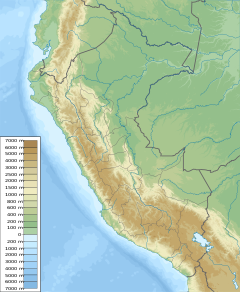Ichigkat Muja National Park - Cordillera del Cóndor
| Ichigkat Muja National Park - Cordillera del Cóndor | ||
|---|---|---|
|
|
||
| Location: | Amazon , Peru | |
| Surface: | 884.77 km² | |
| Founding: | August 10, 2007 | |
The Ichigkat Muja - Cordillera del Cóndor National Park (Spanish: Parque nacional Ichigkat Muja - Cordillera del Cóndor ) is a national park established on August 10, 2007 by Decree Nº 023-2007-AG in the El Cenepa and Río Santiago districts of the province Condorcanqui in the Amazonas region in Peru .
target
The name "Ichigkat Muja" means "tree of the mountains" in the Aguaruna language .
The aim of the park is to preserve the unique ecoregion with mountain forests of the Cordillera Real Oriental . In addition, the biological diversity of the Cordillera del Cóndor should be preserved and the quality and quantity of the water and its spring basins guaranteed for the communities in their vicinity.
The Cordillera Real Oriental runs from northern Peru via Ecuador to southern Colombia. It is characterized by a steep premontane habitat, so that the vegetation varies greatly due to enormous height differences in a relatively small area. It is an evergreen tropical rainforest with predominantly broad-leaved plants. In the area of relatively low elevation, the forests are very dense and lush. The higher you climb, the more this changes into a high cloud forest, which eventually becomes an elf forest . The park is home to the Shuar , known for their mystical culture of shrunken head making . The height differences in the park vary between 500 and 3000 meters. In the park there are the Los Tayos caves , which you can cross via road 5N from Bagua to the village of Chiriaco .
fauna
The biological diversity is enormous with numerous species.
Mammals
Mammals found in the park include the white- foreheaded spider monkey ( Ateles belzebuth ), spectacled bear ( Tremarctos ornatus ), mountain tapir ( Tapirus pinchaque ) and Andean opossum mouse ( Caenolestes condorensis ).
Birds
Among the at least 150 species of birds that live in the park are the Salvinhokko ( Mitu salvini Reinhardt , 1879), the spotted parrot ( Touit stictopterus ( Sclater, PL , 1862)), the brush parakeet ( Leptosittaca branickii von Berlepsch , Stolzmann , 1894), the Parkerzwergkauz ( Glaucidium parkeri Robbins & Howell , 1995), the Napodegenflügel ( Campylopterus villaviscensio ( Bourcier , 1851)), the black and white-tailed Hummingbird ( Phlogophilus hemileucurus Gould , 1860), the spot on the chest sailors ( Cypseloides lemosi Eisenmann & Lehmann , 1962), the Andean dark tyrant ( Knipolegus signatus ( Taczanowski , 1875)), the brown-breasted strangler tangar ( Lanio fulvus ( Boddaert , 1783)) and the fat swallow ( Steatornis caripensis von Humboldt , 1817).
climate
The area has a humid tropical climate. Rainfall is from October to March, with the heaviest in March and April. The average annual rainfall is 2400 to 4500 mm. The dry season is from April to November.
